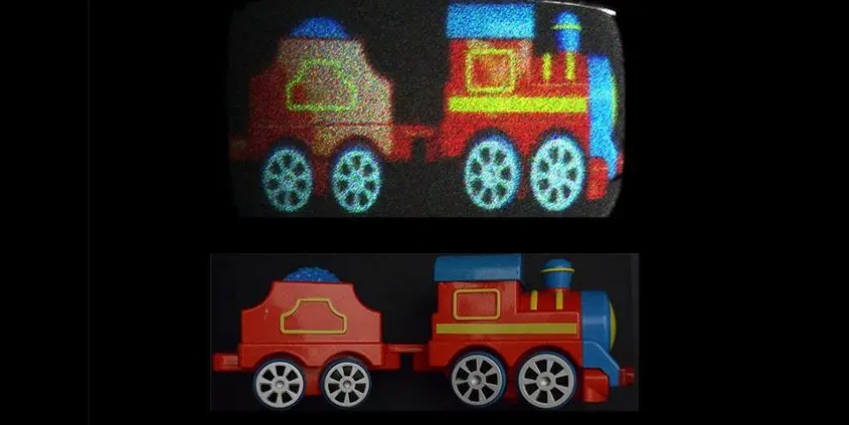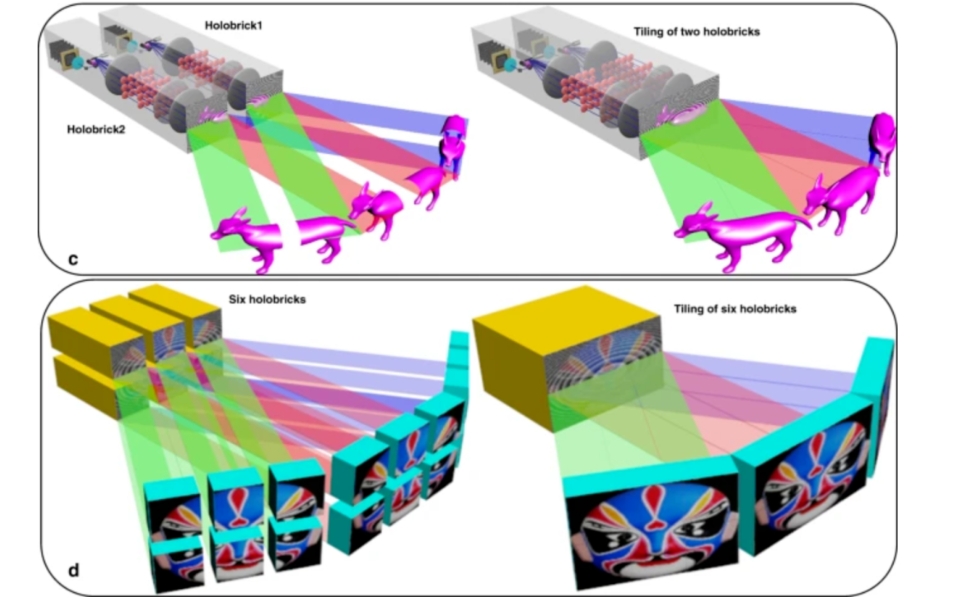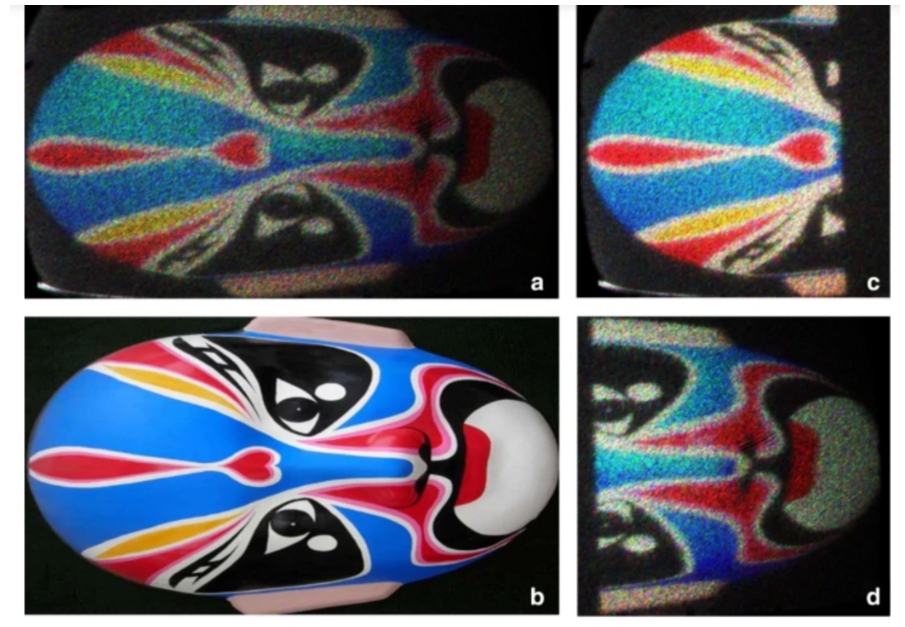Stackable ‘holobricks’ can make giant 3D images
科技的进步发展,让人们对沉浸式的3D视觉体验有了更高需求,特别是随着元宇宙概念的方兴未艾,3D全息显示技术和真正的大型3D显示器,被视为连接现实和虚拟世界的重要技术支撑。
With the development of science and technology, people have a higher demand for immersive 3D visual experience, especially with the rise of the concept of metaverse, 3D holographic display technology and true large-scale 3D displays are considered as important technologies for connecting the real and virtual world.
然而,受视角和可以显示的3D 信息量所限,现有的全息技术图像尺寸小,通常需要人们从特定的距离和角度进行观察才能欣赏它们。
However, limited by the viewing angle and the amount of 3D data flow that can be displayed, current holographic technologies have small image size. That makes people have to observe images from a specific distance and angle.
面对同时实现大视场和大尺寸的全息显示技术痛点,剑桥大学先进光电子研究中心的研究团队开发了如下新方法——全息砖(holobrick),它可以显示高度逼真的全息图像,堆叠在一起后就可以生成大型全息图。该研究近期获得了国内媒体的关注,一起来了解吧。
Faced with the technical pain points of realizing holographic display with large field of view and large size at the same time, the research team from the Centre for Advanced Photonics and Electronics of Cambridge University has developed the concept of holobrick which can be seamlessly stacked to form a scalable spatially tiled holographic image 3D display. The research has get a lot of attention from the domestic media recently, let us check it out.

用全息砖重建的玩具火车全息图像(上)和相机拍摄的原始图像(下)
Reconstructed holographic images of a toy train (top) and original image captured by a camera (bottom)
来自剑桥大学与迪士尼研究院的研究人员合作开发了一种全息砖(holobrick)概念,可以将全息图拼接在一起以形成大型无缝3D图像。这是该技术的首次展示,为可扩展的全息3D显示器打开了大门。该项研究成果近期在《光:科学与应用》杂志上发表。
The researchers, from the University of Cambridge and Disney Research, developed a holobrick proof-of-concept, which can tile holograms together to form a large seamless 3D image. This is the first time this technology has been demonstrated and opens the door for scalable holographic 3D displays. The results are reported in the journal Light: Science & Applications.
随着技术的发展,人们对高质量视觉体验的需求不断增长,从 2D 高分辨率电视到 3D 全息增强或虚拟现实,再到大型真 3D 显示器。这些显示器需要支持大量的数据流:对于 2D 全高清显示器,信息数据速率约为每秒3Gb,但相同分辨率的 3D 显示器需要每秒3TB的速率,这在当前尚无法实现。
As technology develops, people want high-quality visual experiences, from 2D high-resolution TV to 3D holographic augmented or virtual reality, and large true 3D displays. These displays need to support a significant amount of data flow: for a 2D full HD display, the information data rate is about three gigabits per second (Gb/s), but a 3D display of the same resolution would require a rate of three terabits per second, which is not yet available.
全息显示器可以重建高质量图像以获得真实的3D视觉感知,被认为是连接真实和虚拟世界以获得沉浸式体验的终极显示技术。
Holographic displays can reconstruct high-quality images for a real 3D visual perception. They are considered the ultimate display technology to connect the real and virtual worlds for immersive experiences.
领导该研究的剑桥大学工程系初大平教授表示,“使用现有技术提供完美的3D体验是一项巨大的挑战。在过去的十年里,我们一直在与工业界的合作伙伴共同开发能够同时实现大尺寸和大视场的全息显示器,这需要与具有大量光学信息内容的全息图相匹配。”
“Delivering an adequate 3D experience using the current technology is a huge challenge,” said Professor Daping Chu from Cambridge’s Department of Engineering, who led the research. “Over the past ten years, we’ve been working with our industrial partners to develop holographic displays which allow the simultaneous realisation of large size and large field-of-view, which needs to be matched with a hologram with a large optical information content.”
然而,目前全息图信息的信息量远远大于目前光引擎(空间光调制器)的显示能力,因为其空间带宽积有限。
However, the information content of current holograms information is much greater than the display capabilities of current light engines, known as spatial light modulators, due to their limited space bandwidth product.
对于2D显示器,标准做法是将小尺寸显示器平铺在一起以形成一个大显示器。这里探索的方法是类似的,但对于3D显示器,这是首次尝试。同时担任剑桥大学工程系先进光电与电子研究中心(CAPE)主任的初大平教授表示:“将3D图像拼接在一起并非易事,因为最终图像必须从各个角度和深度都被视为无缝的,在真实空间中直接平铺3D图像不太可能。”
For 2D displays, it’s standard practice to tile small size displays together to form one large display. The approach being explored here is similar, but for 3D displays, which has not been done before. “Joining pieces of 3D images together is not trivial, because the final image must be seen as seamless from all angles and all depths,” said Chu, who is also Director of the Centre for Advanced Photonics and Electronics (CAPE). “Directly tiling 3D images in real space is just not possible.”
为了应对这一挑战,在大约七年前,剑桥大学工程系先进光电与电子研究中心与迪斯尼研究院的研究人员共同开发了全息砖单元,该单元基于用于角平铺3D图像的粗略集成全息显示器。
To address this challenge, the researchers developed the holobrick unit, based on coarse integrated holographic displays for angularly tiled 3D images, a concept developed at CAPE with Disney Research about seven years ago.

可扩展的疏集成全息视频显示系统 Schematic of tileable holobricks
每个全息砖都使用高信息带宽空间光调制器与粗集成光学器件一起进行信息传递,以形成具有大视场的角平铺3D全息图。
Each of the holobricks uses a high-information bandwidth spatial light modulator for information delivery in conjunction with coarse integrated optics, to form the angularly tiled 3D holograms with large viewing areas and fields of view.
精心的光学设计确保全息条纹图案填满全息砖的整个表面,从而使多个全息砖可以无缝堆叠,形成可扩展的空间平铺全息图像3D显示,具有宽视角和大尺寸。
Careful optical design makes sure the holographic fringe pattern fills the entire face of the holobrick, so that multiple holobricks can be seamlessly stacked to form a scalable spatially tiled holographic image 3D display, capable of both wide field-of-view angle and large size.

全息显示系统标定后的无缝拼接前后效果
Holographic display results of the two spatially tiled holobricks
研究人员开发的概念验证是由两块无缝拼接的全息砖组成。每块全彩砖的像素为1024×768,视场角为40°,每秒24帧,用于显示平铺全息图的全3D图像。
The proof-of-concept developed by the researchers is made of two seamlessly tiled holobricks. Each full-colour brick is 1024×768 pixels, with a 40° field of view and 24 frames per second, to display tiled holograms for full 3D images.
初教授表示:“制造具有宽视角的超大型3D显示器(例如全息3D墙)仍面临许多挑战,我们希望这项工作能够基于目前空间光调制器有限的显示能力,为解决这个问题带来希望。”
“There are still many challenges ahead to make ultra-large 3D displays with wide viewing angles, such as a holographic 3D wall,” said Chu. “We hope that this work can provide a promising way to tackle this issue based on the currently limited display capability of spatial light modulators.”
Reference:
Jin Li; Quinn Smithwick; Daping Chu. ‘Holobricks: Modular Coarse Integral Holographic Displays.’ Light: Science & Applications (2022). DOI: 10.1038/s41377-022-00752-7
相关研究发表于《光:科学与应用》学术期刊,
您可访问 https://www.nature.com/articles/s41377-022-00742-7 阅读原论文
The results are reported in Light: Science & Applications.
To read the original paper, please visit
https://www.nature.com/articles/s41377-022-00742-7

 中文
中文 English
English
